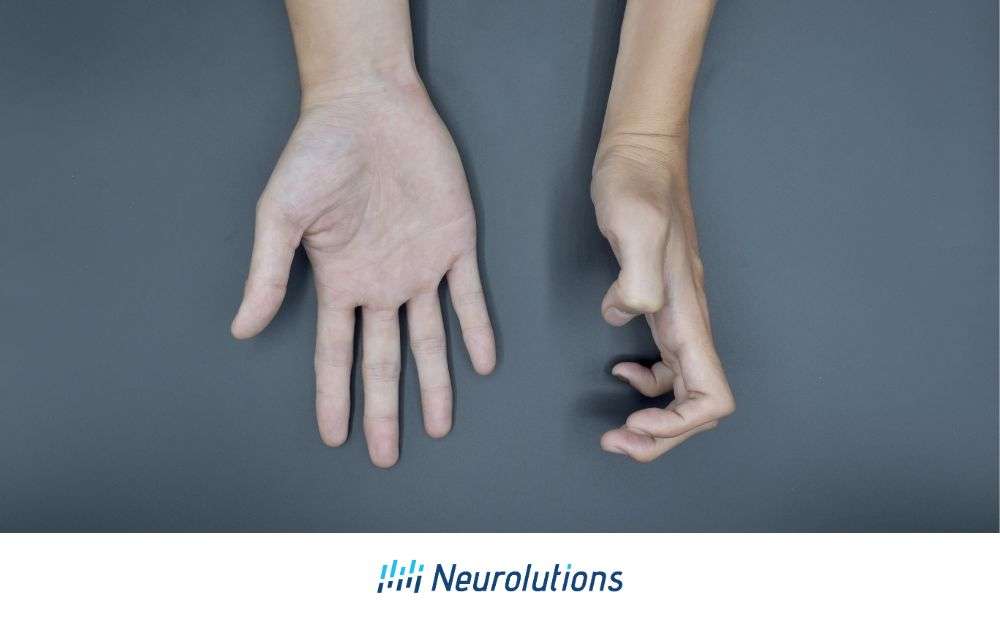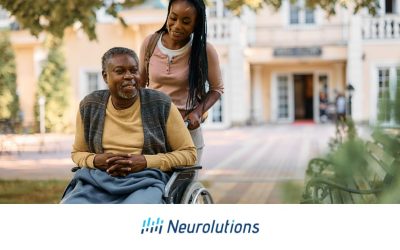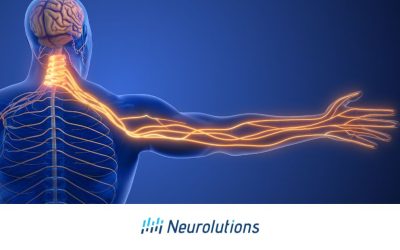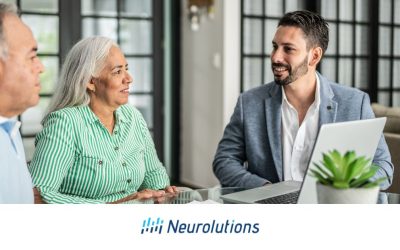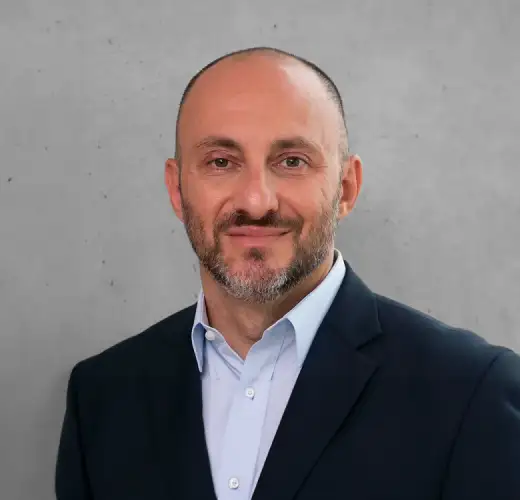Introduction – Does Stroke Cause Muscle Atrophy?
When a stroke occurs in a person, it can damage the brain and may trigger a series of events that ultimately lead to muscle atrophy. Muscle atrophy is a loss of muscle size or mass resulting in muscle weakness. Atrophy begins when the muscles responsible for moving a limb or body part remain inactive due to paralysis or weakness. It can happen as a result of stroke due to the damage to a person’s brain. The damage can impair the brain’s ability to send messages to the spinal cord, therefore affecting its ability to move the limbs and muscles. Therefore, a stroke often causes limb paralysis or weakness, leading to muscle atrophy. In as little as one week of disuse, these muscles can begin to atrophy (1).
The following article will describe the causes and consequences of muscle atrophy, its treatment options, and the crucial role of physical therapy (PT) and occupational therapy (OT) in managing it. It will also outline the various rehabilitation strategies employed by therapists to address muscle atrophy in stroke patients.
What is Muscle Atrophy?
Muscle atrophy happens when stroke survivors experience muscle weakness or paralysis, leading to a decrease in muscle size and strength due to lack of use.
Stroke survivors often experience nerve impairments that cause muscle weakness, paralysis, or spasticity. These conditions can wreak havoc on motor skills, therefore affecting someone’s ability to move an affected limb. This ultimately leads to muscle atrophy, which is a loss of muscle size or mass resulting in muscle weakness.
In most cases of stroke, one hemisphere of the brain is affected, causing paralysis or weakness on the opposite side of the body. For example, if the right hemisphere is affected, it can lead to paralysis or weakness in the left arm, left leg, and left side of the face. Additionally, other body functions can be affected, such as bladder control.
During the early stages of stroke recovery, damage to the pathways between the brain and the nerves may leave a person unable to move a paralyzed or weakened limb. Without regular movement to stimulate these muscles, they can become further weakened, losing both mass and strength. While recovering the nerve pathways is essential for regaining the ability to move muscles, the muscles themselves must be strong enough to perform the desired motor skills, like walking. For a stroke survivor, this means that maintaining muscle mass will make recovering lost motor skills much more attainable.
Contractures due to Muscle Atrophy
Contractures are permanent muscle contractions caused by inactivity after a stroke or brain injury, severely limiting joint movement and flexibility.
A debilitating consequence of muscle atrophy in stroke survivors and people with Traumatic Brain Injury (TBI) is the onset of contractures, which are permanent contractions of muscles resulting from lack of use. Contractures are caused by extended inactivity after events like a paralyzing stroke or TBI and result in the elastic parts of the human body losing their ability to move, hindering joint movement and a full range of motion. Contractures occur most often in the hands and feet. In fact, at six months after a severe stroke, 33% of all stroke survivors have hand contractures, and 50% of those survivors never regain their hand function (2). Therefore, preventing muscle atrophy is vital to preventing permanent disability from contractures.
How Muscle Atrophy Negatively Impacts Motor Skills
Muscle atrophy makes it difficult for stroke survivors to regain motor skills, as weakened muscles cannot support necessary movements, impacting their independence and quality of life.
Muscles collaborate in distinct groups in order to enable our movements. The muscles in the leg, feet, and toes in conjunction with the muscles connected to the hip, knee, and ankle joints enable us to walk. If the muscles that enable the knee to bear body weight are too weak, the leg can “give out”, causing a fall upon attempting to walk. For stroke survivors who are recovering from stroke-induced paralysis or weakness in a leg, atrophy of the muscles in the leg can make it that much harder to recover walking ability.
Regaining motor skills is one of the primary goals of stroke rehabilitation in order to increase a survivor’s independence and ultimately improve their quality of life. A factor that may hamper this progress is stroke-induced depression, which affects one-third of all stroke survivors. Depression often decreases a person’s motivation to participate in the post-stroke rehabilitation that enables recovery of lost motor skills (3). Therefore, maintaining PT and OT exercise routines, while closely monitoring mental health, are crucial for enhancing functional abilities.
Muscle atrophy can be both prevented and treated with activities that promote the following:
- Stretching
- Weight-bearing
- Blood circulation
Muscle Atrophy of the Wrist, Hand, and Fingers in Stroke Survivors
Muscle atrophy in the wrist, hand, and fingers is common in stroke survivors, significantly affecting daily activities and independence if not treated promptly with rehabilitation.
In stroke survivors, muscle atrophy affecting the hand and fingers is a common challenge. Immediately after stroke, paralysis of the hand or arm affects up to 87% of individuals post-stroke (4). This occurs with weakening and tightening of extrinsic muscles, which extend from the elbow and forearm to the hand. Over time, this weakness and the tendency for the wrist to adopt a flexed posture result in difficulties with opening, lifting, and gripping, as the tight or atrophied extrinsic muscles restrict the range of motion and functional capability of the hand and fingers. Additionally, the atrophy of intrinsic muscles within the hand, which are the tiny muscles that originate and end only in the hand, further impairs fine motor control and dexterity, exacerbating the functional limitations and making everyday tasks even more challenging.
Even at 3-6 months after the stroke, at least 40% of survivors continue to face functional limitations with their hand, potentially leading to avoidance of using it (5). This reluctance to use the affected hand can severely impact daily activities such as bathing, dressing, cooking, and even basic tasks like opening a door. Consequently, it jeopardizes a person’s independence. Adding to the problem, the less the affected hand is used in daily activities, the higher the chance of permanent disability. This highlights the importance of early intervention and rehabilitation efforts after a stroke.
Treatment Options for Muscle Atrophy
Treating muscle atrophy involves physical and occupational therapy exercises that include passive and active movements to strengthen muscles and improve nerve communication.
Treatment options for muscle atrophy in stroke recovery are similar to the prevention strategies used in PT and/or OT. PT primarily concentrates on enhancing the patient’s mobility, while OT aims to improve the patient’s ability to perform activities of daily living (6). Both PT and OT incorporate passive, active, and resistive exercises in their treatment approaches to treat muscle atrophy.
Passive Exercises
Passive exercises involve the therapist moving the patient’s body without the patient’s active participation. Passive exercises are utilized to maintain or improve joint flexibility and overall “range of motion.”
Example: The therapist gently moves the patient’s arm through its full range of motion, including flexion, extension, abduction, and adduction. This helps maintain joint flexibility and prevent stiffness.
Active Exercises
Active exercises are performed by the stroke survivor independently or with therapist assistance.
Example: The patient lifts their arm independently or with minimal assistance from the therapist, moving it from the side to above the head. This exercise promotes muscle strength and coordination.
Resistance Exercises
Resistance, or strength-building exercises are aimed specifically at preventing muscle atrophy and are used to improve muscle endurance and strength.
Example: The patient uses a resistance band to perform bicep curls. Holding the band with both hands, the patient pulls upward against the resistance, strengthening the muscles and improving endurance.
All three categories of exercises aim to improve nerve communication to the muscle groups through the spinal cord, ultimately aiding in the prevention and treatment of muscle atrophy and promote overall functional recovery following stroke.
They can be passive or active exercises such as the following:
- The therapist can have the stroke push against the therapist’s own hand or body to strengthen the weakened muscle. This is an active exercise.
- A mechanically-operated machine can move the patient’s body such that both pulling and pushing of a muscle group occurs (7). This is a passive exercise.
- A pulling action by a muscle group through the use of a pull-down gym apparatus. This is an active exercise. A passive exercise alternative is when the patient is asked to pull the therapist’s hand towards themselves.
- Performing an exercise that is weight-bearing such as lifting weights for a specific number of repetitions.
Treatment by Massage, Electrical Stimulation, and the Application of Heat/Cold
Massage, electrical stimulation, and heat/cold therapy are used to improve muscle sensation and function, aiding in the treatment of muscle atrophy.
In addition to passive and active exercises, PTs and OTs may incorporate massage or apply heat or cold to muscles to improve sensation within the muscles. This not only helps address impaired nerve communication to the muscles, it also aids in treating muscle atrophy. Therapists may also utilize electrical stimulation to induce targeted muscle contractions or relaxation, promoting proper muscle functioning (8). These standard treatment methods are used in traditional therapy to reduce muscle atrophy, maintain or increase range of motion, and improve strength in stroke survivors.
Advanced Technology in Stroke Rehabilitation
Advanced technology is increasingly used in rehabilitation to help stroke survivors recover motor skills through regulated exercises and muscle activation.
Advanced technologies are increasingly utilized in stroke rehabilitation to aid in the recovery of lost motor skills and enhance recovery outcomes.
Common advanced technologies include:
- Robotics: Robotic devices assist with repetitive motion exercises and are designed to help patients regain strength and coordination in their limbs.
- Virtual Reality (VR): VR systems create immersive environments where patients can engage in therapeutic exercises in an interactive way.
- Brain-Computer Interfaces (BCIs): BCIs enable direct communication between the brain and external devices, helping to restore motor function by translating brain signals into movements. One non-invasive therapeutic BCI device, the IpsiHand Upper Extremity Rehabilitation System, is cleared by the FDA for chronic stroke patients (≥ six months post-stroke), age 18 or older, undergoing rehabilitation to facilitate muscle re-education and for maintaining or increasing range of motion in the upper extremity.
- Wearable Technology: Wearable sensors and devices track movement and provide real-time feedback, allowing therapists to monitor progress and adjust treatment plans accordingly.
For more information on evidence-based research on advanced technologies, visit Evidence-Based Review of Stroke Rehabilitation (9).
Choosing the Right Rehab Program Following Stroke
Starting physical and occupational therapy soon after a stroke is crucial for recovery, and selecting therapists experienced in stroke rehabilitation is important for regaining motor skills.
Hospitalized stroke survivors are typically prescribed PT and/or OT during their hospital stay as well as following discharge. Beginning PT and/or OT promptly after stroke is crucial for maximizing motor skill recovery, because a delayed start can hamper progress (10). Therapists often assist individuals recovering from injuries or surgeries to regain motor skills. However, the rehabilitation process for stroke survivors is distinct because muscle paralysis or weakness, and loss of motor skills, stem from a brain injury.
Furthermore, strokes often result in cognitive impairments, such as short-term memory loss and difficulties with problem-solving and decision-making. Consequently, PTs and OTs that treat stroke survivors must employ diverse therapeutic strategies to support motor skill recovery.
When selecting both PTs and OTs for post-stroke rehabilitation sessions, it is important to prioritize their experience in treating stroke survivors. Regardless of the therapist chosen, committing to prescribed PT and/or OT exercises is crucial to increase the chances of regaining lost muscle movement ability and related motor skills.
The Critical Role of Exercise in Post-Stroke Muscle Recovery
Muscle atrophy is a common consequence of stroke, characterized by the loss of muscle size and mass. This thinning and weakening of muscle can occur when they are not used during periods of immobility due to upper and lower limb paralysis/weakness and other stroke-related complications. Impaired nerve communications to the affected muscles can cause limb paralysis or weakness, resulting in the lack of use and leading to muscular atrophy. The affected limb may appear thinner and weaker compared to the non-atrophied limb.
Preventing atrophy, reversing paralysis/weakness, and recovering lost motor skills are the primary focuses of rehabilitation for stroke survivors. This proactive approach is crucial, as muscle atrophy in the limbs is linked to poorer PT and OT outcomes compared to stroke survivors without atrophy. Therapists treat muscle atrophy through a variety of exercises and approaches with the aim of regaining lost functional abilities.
Best practice guidelines recommend that stroke survivors participate in rehabilitation programs that incorporate a combination of passive, active, and resistive exercises, along with advanced technologies. This approach effectively addresses muscle atrophy and improves overall rehabilitation outcomes.
References:
- Wall BT, Dirks ML, Snijders T, et al. (2014). Substantial skeletal muscle loss occurs during only 5 days of disuse. Acta Physiol (Oxf) 210(3): 600-611. Webpage: https://pubmed.ncbi.nlm.nih.gov/24168489/
- Eschmann H, Héroux ME, Cheetham JH, et al. (2019). Thumb and finger movement is reduced after stroke: An observational study. PLoS One 14(6): e0217969. Webpage: https://www.ncbi.nlm.nih.gov/pmc/articles/PMC6561636/
- Towfighi A, Ovbiagele B, El Husseini N, et al. (2017). Poststroke Depression: A Scientific Statement for Healthcare Professionals From the American Heart Association/American Stroke Association. Stroke 48(2): e30-e43. Webpage: https://www.ahajournals.org/doi/full/10.1161/STR.0000000000000113
- Knutson JS, Harley MY, Hisel TZ, et al. (2007). Improving hand function in stroke survivors: A pilot study of contralaterally controlled functional electric stimulation in chronic hemiplegia. Arch Phys Med Rehabil 88(4): 513-520. Webpage: https://www.ncbi.nlm.nih.gov/pmc/articles/PMC3961574/#:~:text=Some%20recovery%20of%20motor%20control,usually%20plateauing%20by%206%20months.&text=Yet%2C%2040%25%20to%2080%25,to%206%20months%20post%2Dstroke.
- Knutson JS, Harley MY, Hisel TZ, et al. (2007). Improving hand function in stroke survivors: A pilot study of contralaterally controlled functional electric stimulation in chronic hemiplegia. Arch Phys Med Rehabil 88(4): 513-520. Webpage: https://www.ncbi.nlm.nih.gov/pmc/articles/PMC3961574/#:~:text=Some%20recovery%20of%20motor%20control,usually%20plateauing%20by%206%20months.&text=Yet%2C%2040%25%20to%2080%25,to%206%20months%20post%2Dstroke.
- Occupational Therapy vs Physical Therapy. (2024) MCPHS. Webpage:https://www.mcphs.edu/admission-and-aid/blog/occupational-therapy-vs-physical-therapy
- Wonders J. (2019). Flywheel training in musculoskeletal rehabilitation: A clinical commentary. International Journal of Sports Physical Therapy 14(6):994-1000. Webpage: https://www.ncbi.nlm.nih.gov/pmc/articles/PMC6878857/
- Shi H, Li F, Zhang F, et al. (2023). An electrical stimulation intervention protocol to prevent disuse atrophy and muscle strength decline: An experimental study in rat. Journal of NeuroEngineering and Rehabilitation 20: 84. Webpage: https://jneuroengrehab.biomedcentral.com/articles/10.1186/s12984-023-01208-6#:~:text=Electrical%20stimulation%20(ES)%20is%20an,stimulation%20(LFES%2FHFES).
- Evidence-Based Review of Stroke Rehabilitation (2020): http://www.ebrsr.com
- Johns Hopkins Medicine. Stroke Recovery Timeline. Webpage: https://www.hopkinsmedicine.org/health/conditions-and-diseases/stroke/stroke-recovery-timeline#:~:text=%E2%80%9CThe%20first%20three%20months%20after,in%20their%20outpatient%20therapy%20sessions.

